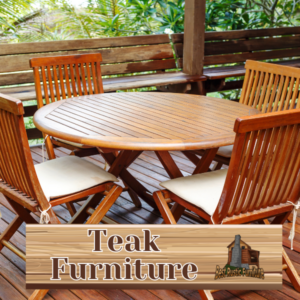
Eco-friendly living has become a significant focus for many individuals seeking to minimize their impact on the environment. A key aspect of sustainable living is the choice of furniture used in homes. Rustic furniture, with its natural and timeless appeal, has gained popularity for its sustainable attributes.
To understand the sustainability of rustic furniture, it is important to delve into the materials used, the manufacturing process, and the durability it offers.
1. Materials Used in Rustic Furniture: Rustic furniture is often crafted from reclaimed or salvaged wood, reducing the demand for newly sourced timber. This helps in the preservation of forests and minimizes deforestation. Other sustainable materials like bamboo or rattan may be incorporated into rustic designs.
2. Manufacturing Process of Rustic Furniture: The crafting of rustic furniture typically involves traditional, handcrafted techniques. This eliminates the need for mass production and reduces energy consumption. Artisans often employ environmentally friendly methods like non-toxic adhesives and finishes to minimize environmental impact.
3. Durability and Longevity of Rustic Furniture: Rustic furniture is known for its sturdiness and durability. The use of solid wood and quality craftsmanship ensures its longevity, reducing the need for frequent replacements and thus minimizing waste.
Choosing rustic furniture offers several benefits beyond sustainability. It includes:
1. Environmental Benefits: By opting for rustic furniture, individuals contribute to the reduction of deforestation, carbon emissions, and waste generation. This promotes a healthier planet for future generations.
2. Health Benefits: Rustic furniture is often made from natural materials, free from harmful chemicals commonly found in conventional furniture. This ensures a healthier indoor environment, reducing the risk of allergies and respiratory issues.
3. Aesthetics and Unique Style: Rustic furniture adds a touch of charm and character to any space. Its unique style and natural beauty create a warm and inviting ambiance, enhancing the overall aesthetics of a home.
When searching for sustainable rustic furniture, consider the following tips:
1. Look for Certified Sustainable Wood: Look for furniture made from wood certified by recognized organizations like the Forest Stewardship Council (FSC), ensuring responsible sourcing and forest management.
2. Avoid Harmful Chemicals and Finishes: Opt for furniture that uses natural, non-toxic finishes and adhesives, avoiding harmful chemicals that can be detrimental to the environment and your health.
3. Support Local and Artisanal Craftsmanship: Choose furniture crafted by local artisans who use sustainable practices, supporting the local economy and promoting traditional craftsmanship.
Incorporating rustic furniture into your sustainable lifestyle can be achieved through various ways:
1. Sustainable Interior Design with Rustic Furniture: Use rustic furniture as focal points in your interior design, creating a harmonious and eco-friendly living space.
2. Outdoor Living and Rustic Furniture: Extend your sustainable lifestyle to outdoor areas by incorporating rustic furniture in your garden or patio, creating a natural and serene environment.
By understanding the sustainability of rustic furniture and making conscious choices, individuals can embrace eco-friendly living while enjoying the beauty and charm of these timeless pieces.
Key takeaways:
- Rustic furniture promotes sustainability: By using materials like reclaimed wood and employing eco-friendly manufacturing processes, rustic furniture contributes to a more sustainable and environmentally-friendly lifestyle.
- Rustic furniture is durable and long-lasting: Due to its sturdy construction and high-quality materials, rustic furniture has a long lifespan, reducing the need for replacement and minimizing waste.
- Rustic furniture enhances the aesthetics of sustainable spaces: With its unique style and natural charm, rustic furniture complements sustainable interior design and outdoor living, creating visually pleasing and environmentally-conscious environments.
Understanding Eco-friendly Living
Understanding eco-friendly living involves making conscious choices to minimize our impact on the environment. Here are some key considerations for practicing eco-friendly living:
- Reduce, reuse, recycle: Opt for products made from recycled materials and support initiatives that promote recycling.
- Energy conservation: Conserve energy by using energy-efficient appliances, turning off lights when not in use, and utilizing natural light sources.
- Sustainable transportation: Choose eco-friendly transportation options such as biking, walking, or using public transportation.
- Water conservation: Decrease water usage by repairing leaks, using low-flow fixtures, and collecting rainwater for outdoor activities.
- Green gardening: Adopt organic and sustainable gardening methods, including composting, using native plants, and avoiding chemical pesticides.
- Mindful consumption: Make informed choices regarding the products we purchase, taking into consideration their environmental impact and supporting brands committed to eco-consciousness.
The Sustainability of Rustic Furniture
Rustic furniture has captured the hearts of many who crave a sustainable and eco-friendly way of living. In this section, we will dive into the environmental aspects of rustic furniture, exploring the materials used, the manufacturing process, and the impressive durability and longevity it offers. Discover how this charming furniture not only adds a touch of rustic beauty to our homes but also contributes to a more sustainable future, making it a truly enticing choice for conscious consumers.
Materials Used in Rustic Furniture
When it comes to rustic furniture, the materials used play a crucial role in its overall aesthetic and durability. Here is a list of common materials used in rustic furniture, such as wood, reclaimed wood, metal, leather, and natural fibers. Wood, being one of the primary materials, adds warmth and natural beauty to the pieces. Popular types of wood include oak, pine, and cedar. Another environmentally friendly option is reclaimed wood, which involves using wood salvaged from old structures, giving it a unique and weathered look. To add a touch of industrial appeal, metal accents like wrought iron or steel are often incorporated into rustic furniture. For upholstery and accents, leather is a popular choice that adds texture and a touch of luxury to rustic pieces. Additionally, natural fibers such as jute, rattan, and seagrass are commonly used for chair seats or woven details in rustic furniture. By understanding the materials used, you can choose rustic furniture that not only suits your style preferences but also aligns with your sustainable lifestyle.
Manufacturing Process of Rustic Furniture
Manufacturing Process of Rustic Furniture involves several steps that contribute to its unique and sustainable qualities.
- Materials: Gather reclaimed wood or sustainably sourced timber to ensure eco-friendliness.
- Design and Planning: Create detailed designs, considering functionality and aesthetics.
- Wood Preparations: Cut, shape, and sand the wood to the desired dimensions and smoothness.
- Assembly: Join different wood pieces using traditional joinery techniques like mortise and tenon or dovetail joints.
- Finishing: Apply natural finishes such as beeswax or linseed oil to enhance the wood’s natural beauty and protect it from wear and tear.
- Quality Control: Inspect each piece for structural integrity and craftsmanship before packaging and shipping.
By following these steps, rustic furniture manufacturers create sustainable and durable pieces that add a touch of natural beauty to any space.
Durability and Longevity of Rustic Furniture
Durability and longevity are crucial considerations when selecting rustic furniture. Here are a few key points to bear in mind:
- Quality materials: When choosing rustic furniture, prioritize pieces crafted from durable and resistant materials like solid wood, such as oak or pine.
- Construction: Pay close attention to the construction techniques employed, such as dovetail joints or mortise and tenon joints. These techniques significantly enhance the furniture’s strength and stability.
- Finishes: Opt for finishes that not only enhance the natural beauty of the wood but also offer protection against scratches and stains.
- Maintenance: Take into account the maintenance requirements of the furniture, such as regular oiling or polishing. Furniture with minimal maintenance needs tends to have a longer lifespan.
- Warranty: Check if the manufacturer provides a warranty for their furniture, as it serves as an indicator of their confidence in its durability.
By opting for well-made and properly maintained rustic furniture, you can be certain that it will endure the test of time and serve as a long-lasting addition to your home.
The Benefits of Choosing Rustic Furniture
Choosing rustic furniture goes beyond just aesthetics – it offers a multitude of benefits. From being environmentally-friendly to promoting better health, rustic furniture brings a unique style to any space. Discover the environmental benefits of this sustainable choice, how it can contribute to our well-being, and the captivating aesthetics that rustic furniture brings to your home. Get ready to learn why embracing rustic furniture is a decision that is beneficial in more ways than one!
Environmental Benefits
Choosing rustic furniture not only adds a unique and aesthetic touch to your living space but also brings several environmental benefits. Here are some environmental benefits of choosing rustic furniture:
- Reduced environmental impact: Rustic furniture is often made from reclaimed or recycled wood, reducing the demand for new materials and minimizing deforestation.
- Sustainable manufacturing process: Rustic furniture is typically crafted using traditional techniques and handcrafted by skilled artisans, reducing energy consumption and carbon emissions.
- Lower carbon footprint: By choosing furniture made locally, you can reduce transportation distances and the associated carbon emissions.
- Promotes circular economy: Rustic furniture can be repaired, repurposed, or upcycled, extending its lifespan and reducing waste.
- Supports sustainable forest management: Look for rustic furniture made from certified sustainable wood, ensuring responsible forest management and conservation.
By considering these environmental benefits, you can make a conscious choice to incorporate rustic furniture into your sustainable lifestyle.
Health Benefits
Choosing rustic furniture for your home not only adds a unique style and charm but also comes with several health benefits.
- Chemical-free: Rustic furniture offers health benefits by being made from natural materials, which are free from harmful chemicals and toxins commonly found in mass-produced furniture.
- Improved indoor air quality: The health advantages of rustic furniture lie in the natural materials used, which do not emit harmful volatile organic compounds (VOCs) that can affect air quality.
- Reduced allergies and sensitivities: Opting for rustic furniture with natural wood and fabrics reduces the likelihood of triggering allergies or sensitivities compared to synthetic materials.
- Enhanced well-being: Embracing the rustic aesthetic creates a cozy and calming environment, contributing to reduced stress levels and improved mental well-being.
Investing in rustic furniture is not just a sustainable choice but also a beneficial one for your health.
Aesthetics and Unique Style
The aesthetics and unique style of rustic furniture make it a popular choice for those looking to add character and charm to their homes. Rustic furniture adds a timeless and authentic feel to any space, thanks to its timeless appeal. The use of natural materials like wood and stone in rustic furniture adds to its unique charm, making it even more desirable. Furthermore, each piece of rustic furniture is often handcrafted, showcasing the skill and craftsmanship of artisans and emphasizing its handcrafted quality. The warm and cozy atmosphere created by rustic furniture can make a space feel inviting and comfortable, providing a cozy environment. Additionally, rustic furniture is versatile in design, allowing it to be incorporated into various styles, from traditional to modern, effortlessly adding a touch of character.
Tips for Finding Sustainable Rustic Furniture
When it comes to finding sustainable rustic furniture, there are a few key tips that can guide you in the right direction. Look for certified sustainable wood, steer clear of harmful chemicals and finishes, and support local and artisanal craftsmanship. These tips not only help you create an eco-friendly living space but also contribute to the overall sustainability of rustic furniture. Let’s dive into each of these sub-sections and uncover the secrets to finding the perfect sustainable rustic pieces.
Look for Certified Sustainable Wood
When searching for sustainable rustic furniture, it is crucial to prioritize certified sustainable wood. Here are some guidelines on how to find what you’re looking for:
- Forest certification: Make sure to choose furniture that is made from wood sourced from forests that are certified by reputable organizations like the Forest Stewardship Council (FSC).
- Chain of custody: It’s important to look for products that have a chain of custody certification. This certification ensures that the wood used can be traced back to its sustainable source.
- Recycled wood: Consider selecting furniture that utilizes recycled or reclaimed wood. By doing so, you can contribute to reducing the demand for new logging.
- Local sourcing: Support local artisans and craftsmen who use locally sourced wood. This not only helps to preserve the environment but also minimizes transportation emissions.
Pro-tip: Always remember to check for labels or certifications that indicate the furniture is made from certified sustainable wood. This way, your purchase can align with your eco-friendly values.
Avoid Harmful Chemicals and Finishes
When choosing rustic furniture for your sustainable lifestyle, it is crucial to avoid harmful chemicals and finishes. By doing so, you not only safeguard your health but also protect the environment. Here are some valuable tips to help you steer clear of any potential harm:
- Make a conscious effort to select furniture crafted from natural, non-toxic materials such as solid wood, bamboo, or reclaimed wood.
- Steer clear of furniture that has been treated with chemical-based finishes, such as varnishes, lacquers, or synthetic paints.
- Consider furniture that embraces natural finishes like plant-based oils or waxes, which are both non-toxic and eco-friendly.
- Give preference to furniture that has been certified by well-known organizations, such as the Forest Stewardship Council (FSC), ensuring both sustainability and non-toxic production.
- Show your support for local and artisanal furniture makers who prioritize the use of environmentally friendly materials and finishes.
Support Local and Artisanal Craftsmanship
“When choosing rustic furniture, it is important to support local and artisanal craftsmanship. This helps promote sustainable practices and supports local economies. Here are some reasons why supporting local and artisanal craftsmanship is beneficial:
- Preserving traditional techniques: Local and artisanal craftsmen often use traditional techniques that have been passed down through generations. By supporting them, we help preserve these techniques and keep them alive.
- Reducing carbon footprint: Buying locally made rustic furniture reduces transportation-related carbon emissions, as the products don’t have to travel long distances.
- Personalized and unique designs: Local artisans often create one-of-a-kind pieces that showcase their creativity and skill. This allows you to have personalized and unique furniture that adds character to your space.
- Supporting local economies: Buying from local craftsmen supports the local economy, helping to create jobs and sustain local communities.
“
How to Incorporate Rustic Furniture in Your Sustainable Lifestyle
Looking to add a touch of rustic charm to your sustainable lifestyle? This section will show you how to seamlessly incorporate rustic furniture into your eco-friendly living. We’ll delve into the world of sustainable interior design with rustic furniture, exploring how these pieces complement your green efforts indoors. And if you love the great outdoors, we’ll also discuss how to create an eco-friendly outdoor living space with the help of rustic furniture. Get ready to embrace the beauty and sustainability of rustic design.
Sustainable Interior Design with Rustic Furniture
Sustainable interior design with rustic furniture offers several benefits, both for the environment and for creating a unique and stylish living space. Here are some key considerations to keep in mind:
- Choose certified sustainable wood: Look for furniture made from responsibly sourced materials, such as reclaimed or FSC-certified wood.
- Avoid harmful chemicals and finishes: Opt for furniture that uses non-toxic and eco-friendly paints, stains, and finishes to minimize indoor air pollution and reduce environmental impact.
- Support local and artisanal craftsmanship: By purchasing rustic furniture from local artisans, you can support local economies and promote sustainable practices.
By incorporating sustainable interior design principles and selecting rustic furniture made with environmentally-friendly materials and processes, you can create a beautiful and sustainable living space that aligns with your values.
Outdoor Living and Rustic Furniture
Hello, John! Thank you for booking our hotel The Grand Palace for your upcoming vacation. We are excited to have you as our guest and want to make sure you have a pleasant stay with us. Please find the booking details below:
| Hotel Name: | The Grand Palace |
|---|---|
| Guest Name: | John |
| Check-in Date: | August 25th |
| Check-out Date: | August 30th |
We hope you have a wonderful time exploring New York City and The Grand Palace! If you need anything during your stay, please do not hesitate to contact our 24-hour front desk. Thank you again for choosing to stay with us.
Some Facts About Eco-friendly Living: The Sustainability of Rustic Furniture:
- ✅ Sustainable wood promotes forest health and conservation, combatting deforestation. (Source: Our Team)
- ✅ Reclaimed wood, salvaged from old buildings, is an eco-friendly choice for rustic furniture. (Source: Our Team)
- ✅ Bamboo, due to its rapid growth and high renewability, is a popular sustainable wood alternative for rustic furniture. (Source: Our Team)
- ✅ Rustic furniture incorporates eco-friendly materials and design principles to minimize environmental impact. (Source: Our Team)
- ✅ Sustainable furniture design focuses on durability and timelessness, creating pieces that last for generations. (Source: Our Team)
Frequently Asked Questions
What is sustainable furniture and why is it important?
Sustainable furniture is furniture that is made using eco-friendly materials, production methods, and design principles. It aims to minimize environmental impact and promote a healthier living space. It is important because it helps reduce deforestation, energy consumption, waste production, and indoor air pollution.
What are some examples of sustainable materials used in furniture production?
Some examples of sustainable materials used in furniture production include reclaimed wood, recycled metal, bamboo, and rapidly renewable resources like jute rugs and natural wool. These materials help reduce environmental impact and promote the conservation of natural resources.
How does sustainable furniture promote waste reduction?
Sustainable furniture promotes waste reduction by utilizing materials like reclaimed wood and recycled metal, which reduces the amount of waste sent to landfills. Additionally, sustainable furniture design principles focus on durability and timelessness, creating pieces that last for generations and reducing the need for frequent replacement.
What are some eco-friendly finishes commonly used in rustic decor?
Some eco-friendly finishes commonly used in rustic decor include natural oils and waxes, water-based stains and paints, and low-VOC (volatile organic compound) finishes. These finishes are non-toxic and have a lower impact on indoor air quality compared to traditional finishes.
How can I create a sustainable home with rustic decor?
To create a sustainable home with rustic decor, you can incorporate eco-friendly materials like reclaimed wood or metal furniture, use eco-friendly finishes, and choose natural materials for rugs and carpets. Additionally, consider zoning your living space to create distinct areas for different activities, using antique pieces or repurposed furniture, and opting for energy-efficient lighting solutions like LED bulbs and solar-powered outdoor lights.
What certifications can help identify sustainable wood?
Certifications such as Forest Stewardship Council (FSC) certification can help identify sustainable wood. FSC certification ensures that the wood is sourced and harvested in an environmentally responsible and socially conscious manner, promoting the long-term health and viability of forests and the communities that depend on them.






